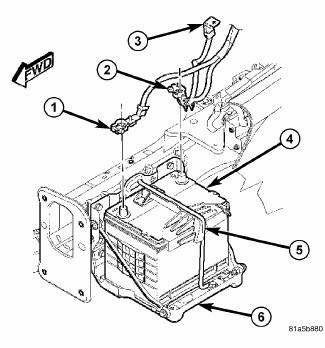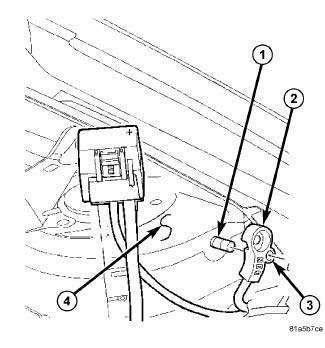Dodge Journey: Description, Operation
DESCRIPTION

Fig. 1: Battery Components
This vehicle is equipped with a single 12-volt battery. All of the components of the battery system are located in the front of the vehicle, just ahead of the left front wheel and tire assembly. The battery system for this vehicle contains the following components:
- Battery (4) - The storage battery provides a reliable means of storing a renewable source of electrical energy within the vehicle.
- Positive (2) and Negative (1) Battery Cables - The battery cables connect the positive and negative charged battery terminal posts to the vehicle electrical system.
- Battery Hold-down (5) - The battery hold-down hardware secures the battery in the battery tray.
- Battery Tray (6) - The battery tray provides a secure mounting location in the vehicle for the battery and an anchor point for the battery hold-down hardware.

Fig. 2: Identifying Battery Cables & Terminals
CAUTION: The negative battery cable remote terminal (2) must be disconnected and isolated from the remote battery post (1) prior to service of the vehicle electrical systems. The negative battery cable remote terminal can be isolated by using the supplied isolation hole (3) in the terminal casing.
For battery system maintenance schedules. For the proper jump starting procedures, Refer to the vehicle Owner's Manual.
OPERATION
The battery system is designed to provide a safe, efficient, reliable and mobile means of delivering and storing electrical energy. This electrical energy is required to operate the engine starting system, as well as to operate many of the other vehicle accessory systems for limited durations while the engine and/or the charging system are not operating. The battery system is also designed to provide a reserve of electrical energy to supplement the charging system for short durations while the engine is running and the electrical current demands of the vehicle exceed the output of the charging system. In addition to delivering, and storing electrical energy for the vehicle, the battery system serves as a capacitor and voltage stabilizer for the vehicle electrical system. It absorbs most abnormal or transient voltages caused by the switching of any of the electrical components or circuits in the vehicle.
 Battery System
Battery System
...
 Diagnosis and Testing
Diagnosis and Testing
BATTERY SYSTEM
The battery, starting, and charging systems in the vehicle operate with one
another and must be tested as a
complete system. In order for the engine to start and the battery to main ...
See also:
Installation
2.4L
Fig. 7: Capacitor 2.4L
- Bolt
- Capacitor
- Connector
1. Install ignition coil capacitor (2) and bolt (1), tighten bolt to 10 N.m
(88.5 ft. lbs.).
2. Connect electrical connect ...
Description
Fig. 161: Rear Heater AC Housing Description
Models with the rear heating-A/C system use a rear heater-A/C housing (1)
that combines A/C and heating
capabilities into a single unit mounted withi ...
WARRANTY INFORMATION
See the Warranty Information Booklet, located on the
DVD, for the terms and provisions of Chrysler Group
LLC warranties applicable to this vehicle and market. ...
